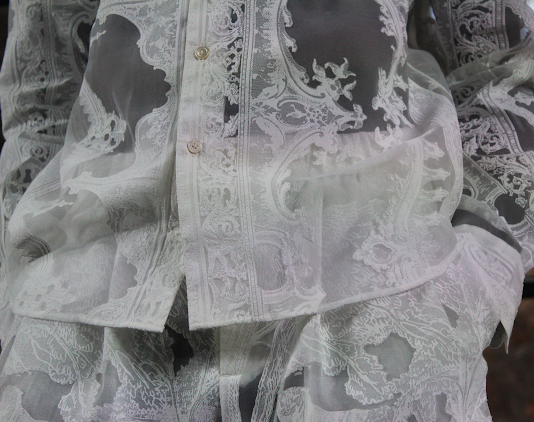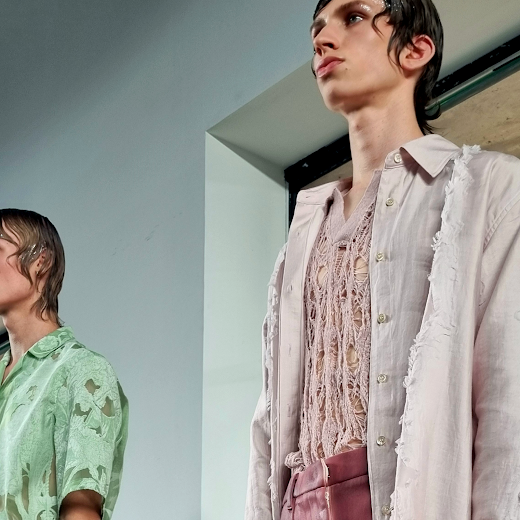Taakk presented their Spring/Summer '25 collection inside the heart of Paris
Fashionweek, Palais de Tokyo. The show was thoughtful and refined and models
walked on raised platforms before stepping down to the floor, giving the
audience a full view of each look from every angle.
Beautiful and sophisticated in its simplicity, the collection plays with
unexpected fabrics, shirts that shift from cotton to wool, jackets that
become shirts. Embroidery becomes Art; patterns are formed from the fabric
itself rather than stitched on. Natural and synthetic fibers merge to create
textures that move and evolve with the body. Denim appears in the
collection as always, and one of the brand’s signatures; distressed,
bleached, and styled with a contemporary edge.
We absolutely loved the collection and were impressed by the level of work
behind it. Every look felt equally strong, there wasn't a single standout
because the quality was consistently high throughout. The embroidered
textures were a highlight, as were the all-white and all-black ensembles.
The finale was understated but striking, models lined up across the stage,
giving guests a rare, up-close look. It was a chance to see the textures,
cuts, and construction that define Taakk's collection. We truly appreciate
the innovation, craftsmanship, and precision tailoring, each executed at an
exceptional level.
Collection notes:
As an island nation, Japan’s culture has developed in a unique fashion. In the
latter years of the 19th century Japan was led towards modernization with heavy
influences from the West, thus incorporating western cultures, lifestyles, and
values into daily life. However Japan was unique in that it took these foreign
cultures incorporated and elevated these outsider elements into a perspective
that was unique and ingenuous. Foods became Yo-shoku ( European Western style
Food ); architecture became Yo-fu Kenchiku (European Western style Architecture
) and fashion became Yo-fuku (European Western style Fashion ). On a global
scale, Japanese culture developed in a manner much akin to the Galapagos. Yo-
meaning 'European' or 'Western' influences.
At times adding to and at other instances subtracting, the aesthetics of Japan
have continued to create internationally relevant pieces of art and culture.
Each such piece holds a strength and brilliance that stands the test of time.
This core is something to be eternally inherited. Through hearts foreign and
domestic. In a similar way that Japanese designers before me. The greats from
the 1980s and the 1990s, Their works shifted the global paradigm and led me to
where I am with such intense shock and admiration. The 'Yo-fuku' ( European
Western style Fashion ) created by these designers demonstrated their
originality to the world, and created the 'Classical' for us Japanese
designers. But I do ask myself, In the modern climate where trends travel a
mile a minute and designers follow suit as part of a huge market. Does this
Galapagos-like uniqueness this 'Yo-fuku' still have a strong presence?
The 'Yo-fuku' that we create have the 'Classical' elements of our predecessors
been properly inherited? Thus I go to the groundwork of technique shifting my
perspective and giving birth and evolution to newness. All in an effort to
discover the possibilities of design. And I add to that, the passion that
stirs my own creativity. The complexity that exists behind simplicity, the
dynamism that breathes within calm, the avant-garde that dwells within polish,
the imaginings and superstitions within the day-to-day the counterpoints. The
items which shake your sense of normality. Everything is an intrigue for such
- 'aha' moments. I believe this when we bring everything together we will
continue sharing with the world, an unique display of 'Yo-fuku'.
Taakk – Yakuta Morikawa
Gradient Woven Fabric
The transition of fabrics from fine cotton to seasonal summer wool and linens
has uncovered new design potential. As the translucent cotton voile shirt
makes its way to the hem, it transitions into a wool tailored jacket. The
union joins two nonchalant characters into a Magritte-like piece of equal
oddity and uniqueness. The linen jacket shifts into a cotton broadcloth
towards the hem, joining a jacket and shirt in one united piece.
Various Embroidery Techniques
Instead of creating embroidery as an additive process, we simplified our
philosophy in search of something more potent. We took the same fabrics used
in the piece and cut them into 7mm and 15mm pieces, artistically arranging
them in a sculpture-like manner. We did so inspired by classical European
decoration, as a direct representation of our perception of what 'Yo-fuku' is.
Creation of Three-dimensional Transparency We created a unique weave with the
unique characteristics of plant and chemical based fibers. A 3-layer fabric
expression was created through plant solvents, remnants of chemical fibers,
and a specialized print to top it all off. The end result ,a more realistic
and dynamic motif.
MYKITA The show's statement sunglasses are handmade in Berlin by pioneering
design house MYKITA, presenting a unique material concept that finds beauty in
the unrefined.
About Taakk:
Designer Takuya's passion for this collection is a series of perforated knit
embroideries with a cable pattern that looks like a tree trunk. The series is
formed entirely by embroidery, using hand-knit low-gauge threads that are
threaded through an embroidery machine. While retaining the bold transparency
of the skin that can be expressed because of the embroidery, the design
creates a familiar sense of security with the cable pattern. Design from
textiles with Taakks unique technology of changing the composition of
textiles. In keeping with the characteristics of the fabric, which changes
from wool twill to cotton cut jacquard, this season it is transformed into a
jacket with a shirt in the center and padding down the sides. It is a
minimalist but new expression of clothing. Taakk's classic iconic denim. This
season, the fabric is frayed from countless joints to create fringes and
chemical wash for depth. The entire collection is colored in browns, beiges,
and blacks, with a beautifully striking lime green inserted into the overall
subdued color palette.





































No comments